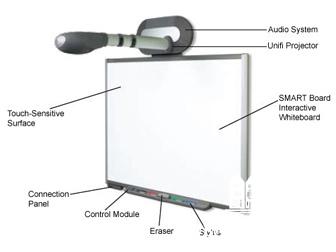(lubavitch.com) Dusty chalk and dry-erase boards are so Twentieth-century. The Hebrew Academy of Huntington Beach, California, known for its progressive educational methods is moving ahead once again.
A recipient of two Blue Ribbon Awards for excellence, this outstanding school—one of the first Jewish day school’s—if not the first—to go green, is once again pushing the educational envelope. Classrooms at the Huntington Beach facility have been outfitted with SMART Boards and beginning this fall, several pioneering programs will utilize this innovative technology.
A cross between a whiteboard and a computer, SMART Boards allow for information to be creatively presented and reviewed (and emailed to students for homework) instantly. Its potential appears boundless, and for youngsters used to “tweeting” and “poking,” the technology is a perfect disguise for serious study.
“SMART Boards address different modalities of learning,” explains Rabbi Yitzchok Newman, dean. “It is essentially a PowerPoint you can manipulate; enabling teachers to maximize their preparation and classroom time, and individualize each lesson.”
Its effects are being felt in every subject and in every grade, but it is in the Hebrew language division that its prospects are really breaking ground. That’s thanks to the innovation of Ms. Miriam Gold, director of Hebrew language at the Academy, and a generous grant she was recently awarded by the Avi Chai Foundation. The Foundation awarded Gold’s program, aimed at teaching Hebrew language concepts and familiarizing students with current events in Israel, a $10,000 grant.
Gold’s curriculum begins with the nightly Israeli news. She will watch and record the broadcast or read and scan an article into the SMART Board system. The students will watch and read the news in Hebrew, learn about the issue at hand (be it political or social), and work on their language comprehension and grammar. Using the same SMART Board, they will then place a call to an alumnus currently studying in Israel to discuss the news. All of this will be done in Hebrew.
A native Israeli, Gold has been living in the United States for 30 years. She is passionate about teaching Hebrew, a skill most her students graduate with, and is excited to introduce this new program.
“Students are very fast with technology,” she says. “They are very ‘with it’ and for them using the laptops and SMART Board will be natural and familiar. The grant helps us get updated computers, purchase a modern camera and microphone [for teleconferencing], and develop the program and training. Without it, we would not be able to do this curriculum.”
“We are energized by the ‘Miriam Gold’s’ – the impressive group of day school teachers who continue to look for new ways to better educate Jewish students,” states Nina Butler, educational consultant for the Avi Chai Foundation. The Foundation received 200 grant requests; Gold was one of a dozen to receive the award. In addition to its financial support, Avi Chai provides educators with SMART Board lesson plans and a Jewish educational technology blog.
“The elementary teachers use the interactivity of the board as an instructional and motivational tool,” explains the school’s technology director, Susan Short. “Both in high school classes and staff development it is extremely useful for annotating diagrams and pictures and then saving those files for later use. Our teachers have reported that the excitement of having the interactive touch surface in their classroom has students more engaged.”
One of those instructors is Alicia Diasio who teaches general studies to first-graders. In the afternoons, she trains other teachers to utilize the SMART Board system and other technologies the school employs. In her classroom, Diasio uses the interactive whiteboard for complementary activities, review games, and comprehension exercises. She believes the technology provides challenged students with a “safe and fun way to get extra practice.” Advanced students become her tutors, thereby “reinforcing their knowledge by teaching others.” Every child, she says, “has a chance to interact.”
“We still teach the Three R’s here, but at the same time we are very progressive,” says Diasio. “We are always looking for ways to individualize instruction. We know the kids really well and are able to personalize software to their individual needs.”
“I never thought I would say this, but I don’t see how I could teach without the SMART Board,” admits Diasio.
The technology is here to stay, and staff, parents, and pupils agree that it is a good thing. But lest one think that robots will be unveiled next at this trend-setting school in Southern California, Newman is quick to object.
“Nothing replaces a teacher,” he insists. “The love that the teachers have for their students will never be replaced. This technology only allows them to teach more efficiently.”

Be the first to write a comment.